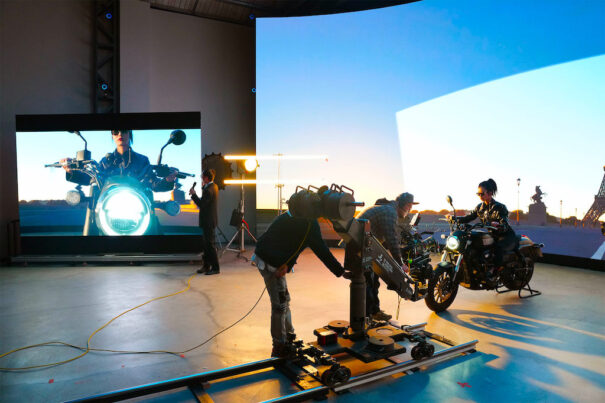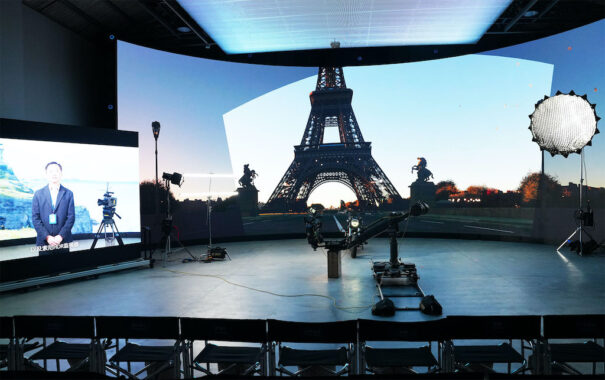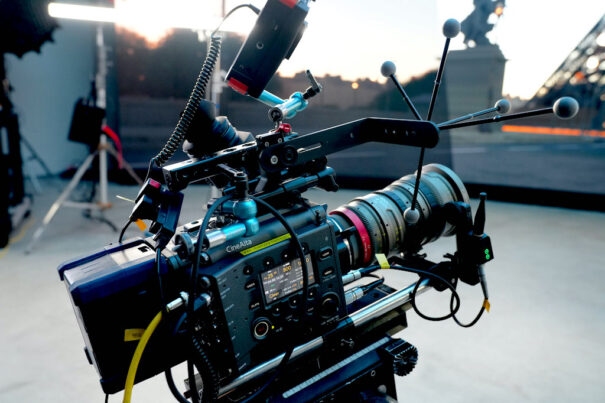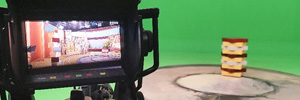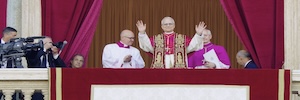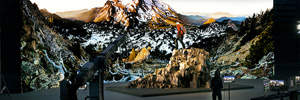Sony y Gwantsi Technology se unen para crear el primer estudio de producción virtual con Crystal LED en China
Situado en el centro de Shanghái (Yuyuan Road), el nuevo estudio virtual impulsado por Sony y Gwantsi Technology ocupa una superficie total de 83 metros cuadrados con una pantalla Crystal LED de la serie B de 5,47 metros de alto y 15,2 metros de ancho, una cámara de cine CineAltaV 2 y un monitor 4K HDR.
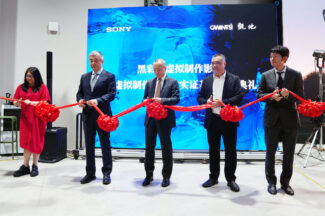 A la inauguración han acudido Takeshi Yoshida, presidente de Sony (China); Zhang Xueqin, directora general de Shanghai Gwantsi Technology y Zhou Chengqing, director técnico jefe de Epic Games (China), quienes pudieron asistir junto a los invitados al evento a una de la tecnología empleada en la producción virtual.
A la inauguración han acudido Takeshi Yoshida, presidente de Sony (China); Zhang Xueqin, directora general de Shanghai Gwantsi Technology y Zhou Chengqing, director técnico jefe de Epic Games (China), quienes pudieron asistir junto a los invitados al evento a una de la tecnología empleada en la producción virtual.
En la ceremonia de inauguración, Mori Kenichi, director de marketing de Sony (China), afirmó que, al compartir la misma visión del sector, así como un fuerte sentido de la responsabilidad y el trabajo, Sony y Gwantsi están realizando esfuerzos conjuntos para construir un estudio de producción virtual de alta calidad en China y contribuir a la filmación virtual en el país.
Sony aspira a crear soluciones de producción virtual de alto nivel. El estudio de producción virtual está equipado con los tres principales productos de Sony, una pantalla Crystal LED, una cámara de cine CineAltaV 2 y un monitor 4K HDR de Sony, lo que establece un estándar de estudio de alta calidad, y ofrece al mercado y a los clientes productos excepcionales, proporciona a los creadores de contenidos una excelente experiencia de usuario y optimiza la creación de contenidos mediante tecnología.
Por un lado, la pantalla LED de 83 metros cuadrados satisface la demanda de los creadores en cuanto al tamaño. Aún con las interferencias de la iluminación del estudio y de los focos Photoflood durante el rodaje, la pantalla LED puede restablecer con precisión la escena en diversas ocasiones e iluminar con colores intensos y delicados.
La pantalla ofrece colores precisos e imágenes de calidad cinematográfica incluso sin necesidad de complicados procesos de corrección de tonos, lo que permitirá que el público no pueda distinguir entre el mundo real y el virtual.
Todos los invitados al acto elogiaron la demostración destacando que el estudio de producción virtual puede reducir considerablemente la preparación del escenario en los estudios tradicionales para facilitar la creación, acortar el periodo de rodaje and ahorrar costes de filmación.
Tecnologías futuristas
Esta demostración es una prueba del éxito de Sony a la hora de ofrecer un modelo de producción virtual. Además, la compañía nipona consigue esto gracias a sus múltiples años de experiencia en la producción de cine y televisión, y a la I+D de sus “tecnologías futuristas” para la producción virtual.
Por ejemplo, los ingenieros de Sony han introducido numerosas mejoras en el producto para adaptar la pantalla Crystal LED al estudio virtual. Esta puede mostrar imágenes con un brillo de hasta 1800 nits para suprimir las interferencias de la iluminación. Además, ofrece un excelente rendimiento antirreflectante with a índice DOI de 0 y poca reflexión.
La pantalla Crystal LED también cuenta con un alto contraste de 10000:1 para detallar las sombras y captar sus cambios sutiles, y para aumentar la intensidad de la imagen. Su amplio ángulo de visión de 170 grados en horizontal/170 grados en vertical ayuda a evitar la desviación del color cuando se filma desde un lateral, lo que proporciona a los directores más libertad creativa para filmar desde un gran angular.
Gracias al potente chip X1 de Crystal LED, la pantalla muestra colores intensos y brillantes. El chip líder del sector impulsa el excelente rendimiento de la pantalla LED con una amplia gama que incluye sRGB, DCI-P3 y BT.2020.
Además, Sony también ha desarrollado dos funciones para la producción virtual. Una de ellas es la conjunción de Camera Sync, la pantalla Crystal LED de la serie B y CineAltaV/CineAltaV 2 mediante el ajuste del ángulo de obturación de la cámara y la frecuencia de cuadro en la pantalla a través de algoritmos avanzados. Esta función puede reducir eficazmente los fenómenos no deseados cuando la cámara filma la pantalla LED, lo que proporciona al público imágenes ideales detrás del monitor.
La otra es Art-Net para admitir el protocolo de control de iluminación convencional, que permite controlar la pantalla LED como iluminación y ajustar la temperatura de color y el RGB de la pantalla LED, junto con otros equipos de iluminación, en la misma interfaz de uso para agilizar el flujo de trabajo.
Además de estas tecnologías futuristas, el estudio de producción virtual también adopta un diseño único; dentro del estudio, una pantalla LED móvil permite a los directores realizar filmaciones con doble cámara, reducir la presión de procesamiento, complementar las imágenes de diferentes posiciones y completar tareas, como el relleno de luz y el posicionamiento en tiempo real de alta calidad.
Captura de movimiento
Además, en la ceremonia de inauguración, se mostró a los invitados cómo funciona la captura de movimiento en tiempo real. La captura de movimiento se ha convertido en una de las tecnologías de vanguardia más habituales en la creación cinematográfica y televisiva. El estudio virtual ofrece esta tecnología punta gracias al avanzado sistema de procesamiento en tiempo real UE5 y al sistema óptico de seguimiento de captura de movimiento OptiTrack.
A total of 24 cámaras de alta velocidad pueden capturar con precisión el movimiento de la cámara de seguimiento y enviarlo a UE5, mientras que el procesamiento puede mostrarse en tiempo real en pantallas LED con baja latencia.
Cabe destacar que el estudio virtual no se construyó de una sola vez, sino tras un periodo de preparación y diseño de casi cuatro años. Antes de la incorporación de la producción virtual, Sony ha realizado numerosas investigaciones, pruebas y verificaciones de productos y sistemas relacionados, se ha esforzado por crear productos y soluciones de alto nivel en el sector y ha seguido las demandas del mercado de soluciones de producción virtual. Para ello, ha realizado pruebas con Epic Games para aplicaciones virtuales y ha publicado un white paper técnico. Los equipos de Sony han demostrado ser excelentes en tecnologías clave como el efecto moiré, los detalles de las sombras y el ángulo visual.
Zhang Xueqin, directora general de Shanghai Gwantsi Technology stá satisfecha con el estudio, y cree que el rodaje virtual acortará enormemente el periodo de producción y reducirá los costes de los departamentos de relaciones públicas y utilería, así como la presión de la localización y el montaje de escenarios, lo que permitirá completar unas 40 tomas al día. Además, el estudio ya ha colaborado con varias marcas famosas para la filmación.
Mori Kenichi, director de marketing de Sony (China), también afirmó que Sony seguirá invirtiendo en investigación y desarrollo para ofrecer soluciones de producción virtual más sofisticadas a los creadores. Al mismo tiempo, el estudio de producción virtual Crystal LED también tiene intención de participar en la producción de publicidad, películas y series de televisión. Para los clientes que desean una producción de alta calidad, las características del estudio de producción virtual Crystal LED pueden satisfacer sus requisitos de alto nivel.
Did you like this article?
Subscribe to our NEWSLETTER and you won't miss a thing.



